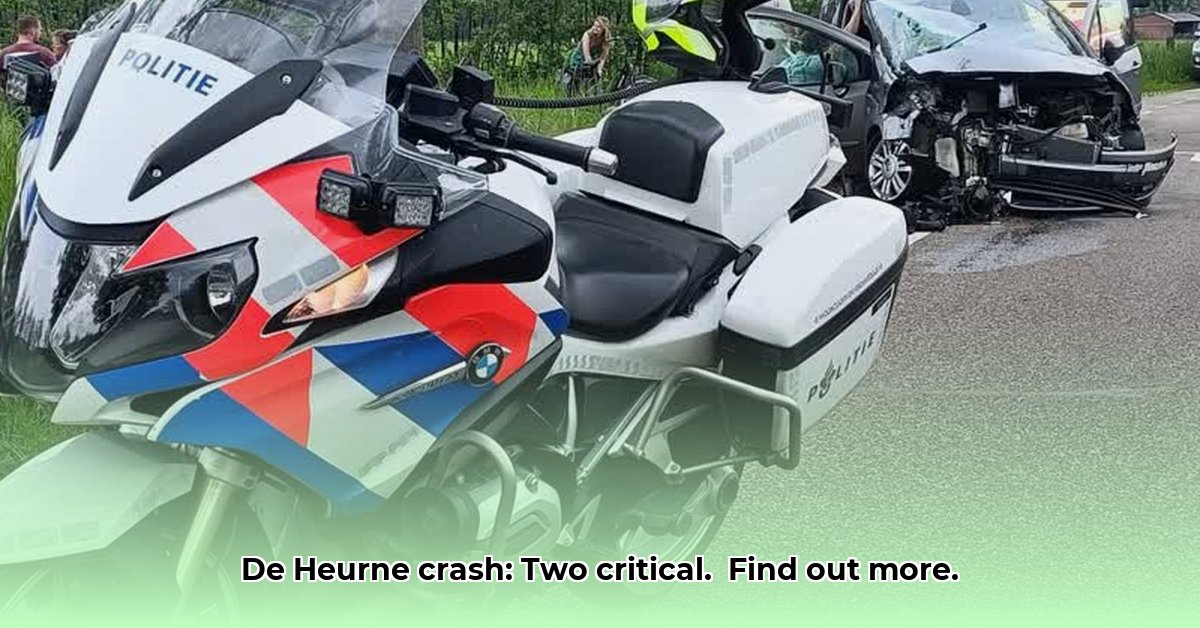
A Devastating Crash on the Varsseveldseweg
A serious car accident on the Varsseveldseweg near De Heurne on 22 June 2025, left a 19-year-old man and a 22-year-old woman with serious injuries. The single-vehicle crash resulted in extensive damage to the car, which collided with several trees. Emergency services, including ambulances, responded swiftly to the scene. The road was closed for several hours, causing significant traffic disruption. Paramedics worked to stabilise the injured before transporting them to hospital. The full extent of their injuries remains undisclosed. But how did this accident happen? And what can be done to prevent similar tragedies?
"The scene was truly horrific," said Constable Pieter van der Merwe, Traffic Sergeant at the local police station in Varsseveld. "The car was beyond repair. We're still piecing together exactly what happened."
The investigation is ongoing, with police exploring several possibilities. Was driver error involved? Was there a mechanical failure? or Were there unforeseen road conditions that played a role? The location of the accident, a stretch of rural road, is also a factor. The police are meticulously examining all aspects of the incident to establish the sequence of events and contributing factors. Even seemingly small details, such as the victims' hometowns (reportedly Westendorp and Dinxperlo), are being verified as part of the thorough investigation.
This accident highlights the urgent need for improved road safety measures. How many more lives must be risked before we act decisively? What measures can we take to limit the human cost of such incidents? The investigation's findings will be crucial in shaping future safety initiatives.
Understanding the Challenges and Implementing Solutions
The Ongeluk De Heurne incident underscores the vulnerability of rural roads and the need for a comprehensive approach to road safety. This isn't just about fixing a road; it's about saving lives.
- Immediate Action Required: Swift implementation of short-term solutions is crucial. This could involve improved road signage, enhanced road surface maintenance, and increased visibility in accident-prone areas.
- Long-Term Strategies: The longer-term vision must include a complete road safety audit, a public awareness campaign focusing on rural road safety, and the evaluation of improvements in driver training.
- Collaboration is Key: A multi-agency approach is vital, involving local government, emergency services, and insurance companies.
The table below outlines responsibilities and actions for key stakeholders involved:
| Stakeholder | Short-Term Actions (0-1 year) | Long-Term Actions (3-5 years) |
|---|---|---|
| Emergency Services | Improve response times and training in vehicle extraction techniques; better resource allocation | Invest in advanced equipment and trauma care. |
| Local Government | Improve road signs; upgrade road surfaces; improve street lighting | Conduct road safety audits; launch a public road safety campaign. |
| Traffic Police | Thorough investigation of the crash; study accident data on similar incidents | Run road safety campaigns; stricter and consistent enforcement of traffic laws. |
| Insurance Companies | Timely and fair claims processing; clear communication with affected individuals | Evaluate risk assessment; consider driver training program support. |
Preventing Future Tragedies: A Multi-pronged Approach
The Ongeluk De Heurne accident serves as a stark reminder of the risks associated with rural roads. How can we make our roads safer, particularly in rural areas, and avoid future tragedies? What steps are necessary to ensure better outcomes for motorists?
Addressing Rural Road Hazards
Rural roads often present unique challenges, including winding routes, poor lighting, and uneven surfaces. These factors, coupled with higher speeds and potential for wildlife encounters, result in more dangerous driving conditions. Driver fatigue further increases this risk.
A Multi-faceted Safety System
Adopting a multi-pronged approach, drawing inspiration from successful, internationally recognised “Safe System” models, is essential. These methods focus on mitigating risk across multiple factors, improving the safety of the roads for all users.
Improved Road Infrastructure: This includes better signage, clearer road markings, better lighting in high-risk areas, and rumble strips. Regular maintenance is also essential to address potholes and uneven surfaces.
Enhanced Vehicle Maintenance: Regular vehicle safety checks and maintenance should be mandated, focusing on tyres, brakes and steering.
Comprehensive Driver Education: Enhanced driver education programs are needed, emphasising defensive driving techniques, risk assessment, and adaptable driving in various road conditions.
Stricter Speed Enforcement: Consistent enforcement of speed limits, using speed cameras and regular patrols, is necessary to deter speeding.
Efficient Emergency Response: Improvements in the speed and efficiency of emergency services in rural areas are vital, encompassing improved communication systems and strategic resource allocation.
By implementing these measures, we can significantly reduce the risk of single-vehicle accidents on rural roads and protect lives. This requires a collaborative effort from all stakeholders, from government authorities and emergency services to driver education providers and insurance companies. The cost of inaction significantly outweighs the cost of prevention.